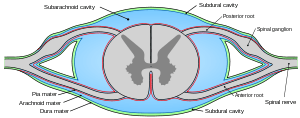Subdural space
| Subdural space | |
|---|---|
 Diagrammatic representation of a section across the top of the skull, showing the membranes of the brain, etc. ("Subdural cavity" visible at left.) | |
 Diagrammatic transverse section of the medulla spinalis and its membranes. (Subdural cavity is colored green, labeled at bottom and top right.) | |
| Details | |
| Identifiers | |
| Latin | spatium subdurale, cavum subdurale |
| TA | A14.1.01.109 |
| FMA | 83803 |
The subdural space (or subdural cavity) is a potential space that can be opened by the separation of the arachnoid mater from the dura mater as the result of trauma, pathologic process, or the absence of cerebrospinal fluid as seen in a cadaver. In the cadaver, due to the absence of cerebrospinal fluid in the subarachnoid space, the arachnoid mater falls away from the dura mater. It may also be the site of trauma, such as a subdural hematoma, causing abnormal separation of dura and arachnoid mater. Hence, the subdural space is referred to as "potential" or "artificial" space.
See also
References
This article incorporates text in the public domain from the 20th edition of Gray's Anatomy (1918)
External links
- Haines, Duane E.; Harkey, H. Louis; Al-Mefty, Ossama (1993). "The "Subdural" Space". Neurosurgery. 32 (1): 111–20. doi:10.1227/00006123-199301000-00017. PMID 8421539.
- Subdural space at the US National Library of Medicine Medical Subject Headings (MeSH)
This article is issued from Wikipedia - version of the 5/27/2015. The text is available under the Creative Commons Attribution/Share Alike but additional terms may apply for the media files.